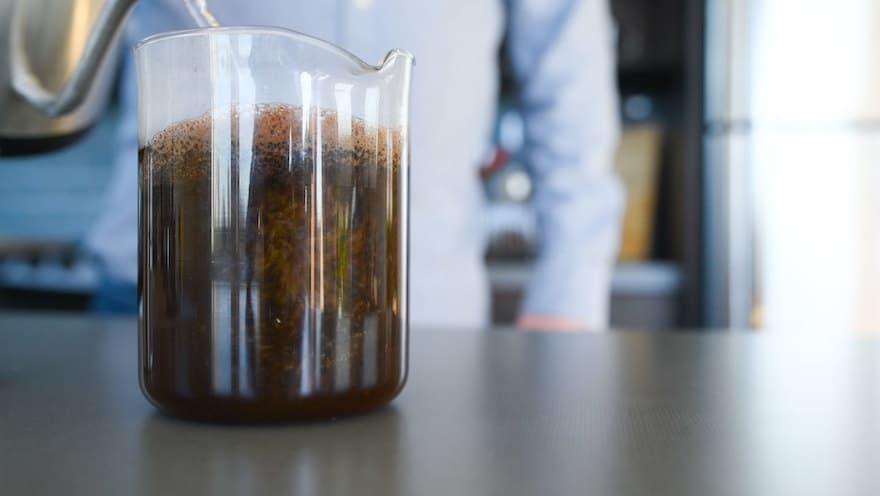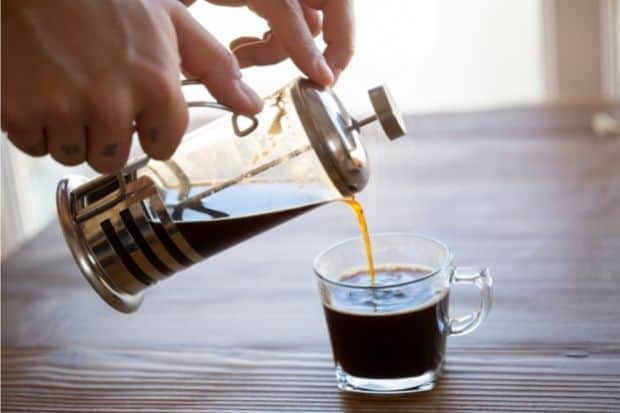Just so you know, as an Amazon Associate we earn from qualifying purchases made via bold red links, buttons or images.
Last Updated on December 15, 2023
French press coffee depends more than most styles on getting just the right grind, so if you love this brewing method, then it makes sense to find the best French press coffee grinder you can.
I love French press. It’s my go-to brewing method on an average weekday morning at home. I love the simplicity of the the brewing process and the silky quality to the coffee as you drink it, owing to preservation of the coffee beans’ natural oils.
A great coffee grinder for French press could be either electric or manual. An electric grinder will certainly make the job easier, but it’s bound to be more expensive. If you don’t mind putting in a little of work, you can still get an ideal, even grind from a manual grinder.
So let’s start off with the best grinder for French press in each of these categories.
Best electric coffee grinder for French press
Baratza Encore
https://m.media-amazon.com/images/I/31rdDgM7N9L.jpgCheck availability
To be clear, you can find better electric coffee grinders than the Baratza Encore. But if you’re a non-professional coffee enthusiast looking to get into your first electric burr grinder, you cannot find better value.
The Encore has 40 grind settings and can grind for everything from French press to espresso. Serious espresso lovers will disagree with that last part. The Encore doesn’t grind fine enough to allow you to finesse a perfect shot of espresso, but with a pressurized portafilter you certainly can turn out something drinkable. For all other types of coffee, it’s up to the task.
With the Encore, Baratza has focused on the basics—just the essentials you need for a burr grinder and no more. You won’t find a scale, a timer, or any way to control your dose, but you will find simple controls and almost no learning curve.
The Encore has a slow motor that makes you wait a bit for your grounds, but it’s a quiet coffee grinder that keeps the heat down.
The conical burrs are stainless steel. They can be a bit challenging to remove for cleaning, especially when they’re coated with oil—which is unfortunate because that’s usually when you need to clean them.
Those small drawbacks aside, this is a legit electric burr grinder that can open the door to a whole new world of coffee for you: pour-over, Aeropress, moka pot, percolator, you name it.
And Baratza is famous for their great customer service, so if anything goes wrong, rest assured it will be addressed.
Let Gail from Seattle Coffee Gear show you around the Encore in this video:
Runner up: Rancilio Rocky
https://m.media-amazon.com/images/I/41PZbjvygxL.jpg
Check availability
This Italian-made favourite will be waiting when you’re ready to take your coffee game up even another notch. The Rancilio Rocky is a durable, 18-pound piece of slick European design with high-quality flat steel burrs and 55 grind settings. Great at keeping the heat and the noise down.
Best manual coffee grinder for French press
Hario Skerton Pro
https://m.media-amazon.com/images/I/416-s-WvUuL.jpgCheck availability
This is the grinder we recommended in our post about essential home barista gear, and nothing has happened since then to change our mind. In fact, it looks cuter on the counter every day.
Of course, looks have little to do with quality coffee. What’s really great about the Hario Skerton Pro is the high-quality conical ceramic burrs at a very affordable price point. It will give you a nice, consistent grind on each of its 12 settings, including those little nuggets you want for your French press.
The grinder comes apart really easily for cleaning but always feels solid when you put it back together.
Your arm will get a bit of a workout from the cranking, as it takes about a minute to grind enough coffee for a single serving of French press. But that’s the physical price you pay for having them knock $100 off the price of an electric grinder at the cash register.
And hey, no static!
Once again, here’s Gail from Seattle Coffee Gear with a little demo:
Runner up: Porlex Mini (or Tall)
https://m.media-amazon.com/images/I/31mtay8-6yL.jpg
Check availability
The Porlex manual grinders (Mini and Tall) are loved by travellers because they are tiny and, being made of steel, pretty much indestructible. They only grind enough for one cup at a time, but if you have small hands you might actually prefer these to the Skerton. Easier to hold, and they grind a bit faster. The burrs are conical and ceramic.
Things to consider when choosing a coffee grinder
When you choose a coffee grinder, here are some things you’ll want to take into consideration:
Adjustable grind settings: This doesn’t apply to blade grinders, but burr grinders should allow you to select the size of the grind. Some will have way more settings than others. If French press isn’t the only style of coffee you’ll be making, then you’ll want to make sure it has the right settings to accommodate whatever style you’ll be making. For espresso or Turkish coffee, you need the ability to set for a very fine grind.
Consistency: Again, blade grinders are somewhat inconsistent by their very nature, but burr grinders ought to be able to give you grounds that are consistent in size. Why does it matter? Variations in size mean that some grounds will be under-extracted and some will be over-extracted, so you’ll get a mix of undesirable flavours.
Ease of cleaning: The darker your roast preferences, the more frequently you’ll need to clean your grinder. Dark roasting brings a lot of oil to the surface of the bean, and that will leave a residue that accumulates in your grinder over time. It’s easy enough to wipe away from a simple blade grinder, but to get it out of a burr grinder you need easy access to the burr chamber for cleaning.
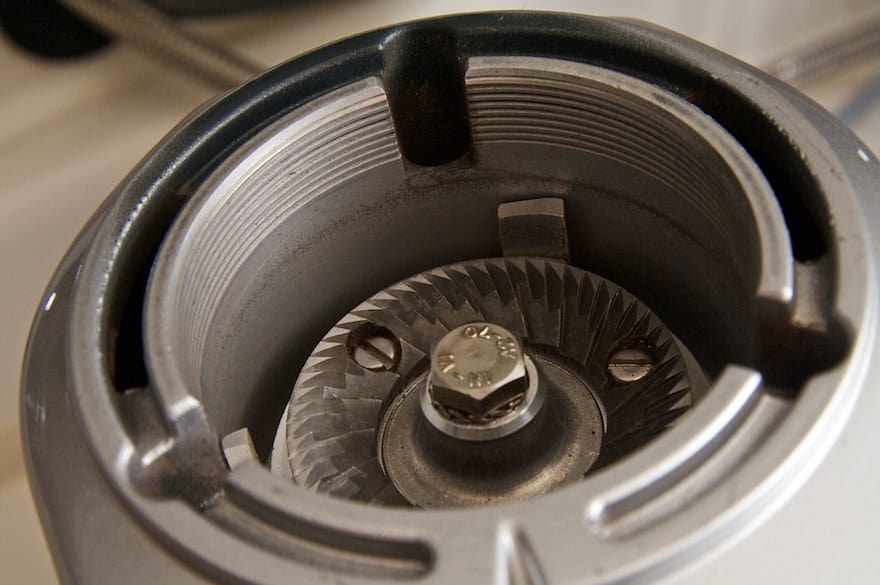
Heat and static: The faster and longer a grinder’s parts spin, the more heat and static electricity they generate. Heat can draw oils out of the beans prematurely, which will ultimately leave you with less tasty coffee. Static is an invisible electrical charge that can cause your grounds to jump out of the grinder when you open it, or stick to the lid, or stick to the sides of the chamber. It’s annoying. Generally speaking, high-speed grinders generate the most heat and static. Slower ones will cut down on it. Grinders with a lot of plastic are more prone to static than those that are primarily metal.
Size: This one is self-explanatory. You know your counter space, so choose a grinder that will fit in.
Noise: If you’re worried about waking housemates in the morning, this will be a consideration. Lower speed grinders tend to make less noise (bonus: less heat and static as well), and of course, manual grinders with a crank will make less noise than anything.
Capacity of bean hopper: Unless you entertain a lot, you’re probably grinding for one or two people most of the time, which means you don’t need room for a lot of beans. Don’t grind any more than you need to—the best coffee comes from freshly ground beans. If you grind extra, those grounds will begin to deteriorate almost immediately and won’t be the same when you get around to brewing your next cup.
Burr grinder vs. blade grinder
I’ll just say it: Burr grinders are better than blade grinders.
That doesn’t mean you can’t get a blade grinder and save a little money if your coffee needs are pretty basic. In fact, you probably should. If all you want is a quick cup of drip coffee in the morning, a blade grinder will certainly do the job. But if you’re interested in experimenting with different styles and trying to get the best cup you can, only a burr grinder can give you the control you need.
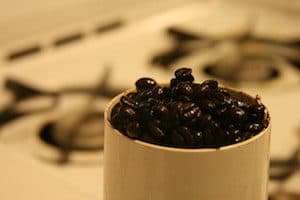
Blade grinders, available everywhere kitchen accessories are sold, don’t grind coffee beans so much as they slice them. The blades are like whirring knives that hack right through the beans. And they’ll keep hacking through them as long as you keep them spinning. To get a finer grind, you just grind longer.
The main drawback of blade grinder is the inconsistency of the grounds. Some bits of the bean get hacked many times and become very small. Others get hacked only a few times and remain quite big chunks. When you brew, you will inevitably get a mixture of over-extraction and under-extraction (and some just right).
A burr grinder grinds beans by crushing them between two surfaces, and you get to control the size of the gap between those surfaces. Because all the grounds ultimately fall through the same gap, they are quite uniform in size. Nice, even extraction is the result.
Conical vs. flat burr grinder
Burr grinders will usually have one of two types of burrs: conical or flat. In both cases, one burr rotates while the other remains stationary. The coffee grounds get crushed between the two. Flat burrs more or less mirror each other in a parallel setup. Conical burrs consist of a “male” and a “female” part with one inserting into the other. Flat burr grinders tend to cost a little more but produce a slightly more consistent grind size. Conical burr grinders are a bit more affordable and usually quieter.
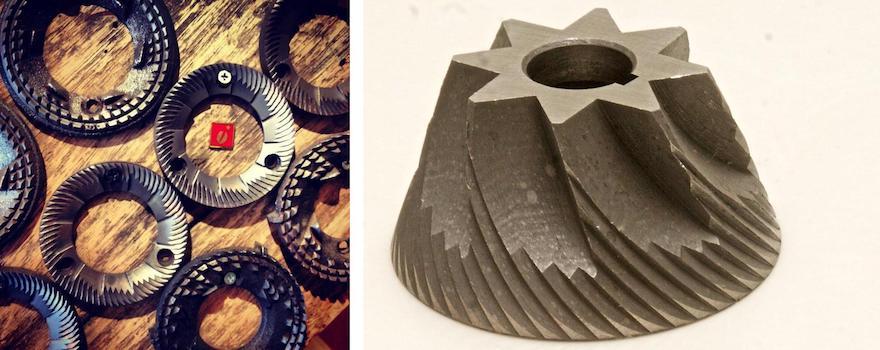
Ceramic vs. steel burr grinder
Those burrs come in ceramic or steel. Ceramic burrs don’t conduct heat like steel ones do, so are less likely to draw oil out of the beans. Ceramic also stays sharp longer than steel so these can go longer before they’ll need replacing. That is, unless you drop them and break them while cleaning—ceramic is more fragile than steel.
How to grind coffee beans for French press
Understanding how coffee extraction works is helpful to understanding why the grind matters so much. When you brew coffee, the interaction between the water and the ground beans draws flavour compounds out of the grounds. The fats and acids come first, then the sugars, and finally the plant fibres.
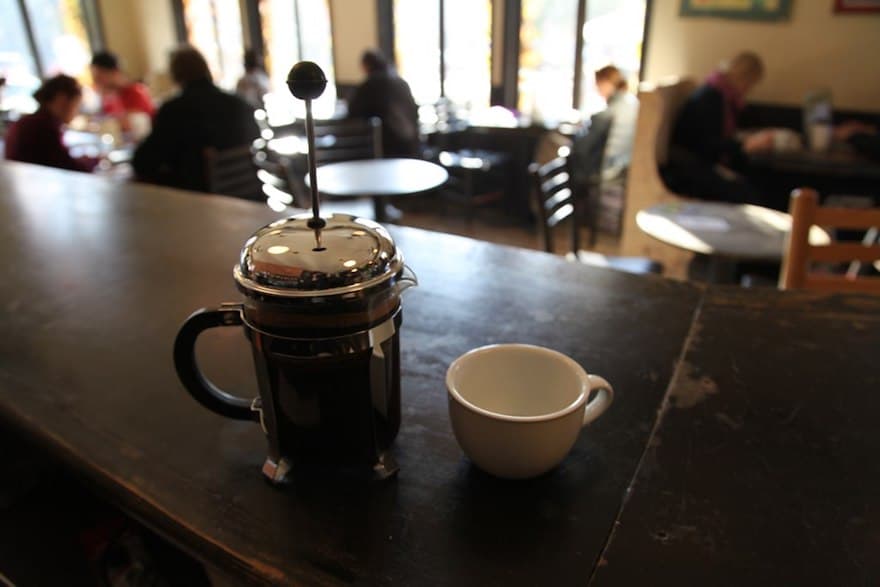
These compounds all taste different, but the important things to remember are that fats and acids are viscous and sour, while plant fibres are bitter. Extract too little and you’ll get sour coffee. Extract too much and it will be bitter. The sweet spot (of course) is in the middle.
French Press grind size
What does all this have to do with grind size? Well, a big factor in the amount of extraction you get will be the ratio between the volume and the surface area of the grounds. Smaller grounds have much less volume compared with their surface area, which means everything gets extracted more quickly when water interacts with the surface. With bigger grounds, the extraction happens more slowly.
Small grounds not only produce bitter coffee through over-extraction, they also are more likely to pass through the mesh screen on the plunger when you attempt to separate the grounds from the coffee. That means coffee that’s bitter AND muddy.
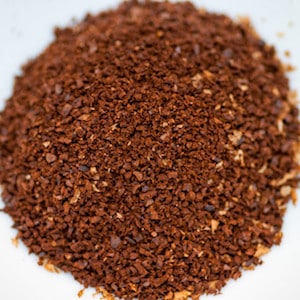
So when you make French press, aim for coarse coffee grounds. If you’re using a burr grinder (more on that in a moment) it should have a coarse setting. If you’re using a blade grinder, you can start by pulsing it and check the grind size after a few pulses to see when you’re getting close.
The ideal size is like coarsely ground pepper, or store-bought breadcrumbs. Have you ever bought graham-cracker crumbs to make a cheesecake crust? Perfect.
I Need Coffee has a great guide to grind sizes, with pictures that include a nickel for comparison.
If you try a nice, coarse grind and you end up with watery, under-extracted coffee, just let it steep a bit longer next time to let the extraction play out. That’s a much easier (and less risky) solution than grinding smaller and trying to keep sediment out of your coffee.
While size matters, so does uniformity—for the best coffee, the grounds should all be the same size. That’s hard to achieve with a blade grinder, as we’ll soon see.
Coffee to water ratio for French press
Grind size, steeping time, and coffee-to-water ratio all matter, and they all work together to create a great French press coffee. Here are some rough guidelines for coffee-to-water ratio:
| Volume of water | Volume of beans |
|---|---|
| 1 cup | 2 tbsp |
| 2 cups | 1/4 cup |
| 4 cups | 1/2 cup |
| 8 cups | 1 cup |
In closing…
If you have the tools to produce grounds that are just the right size, consistent throughout your batch and consistent from day to day, then you’ll be drinking the best French press coffee. Grinders are the most important investment you can make as a coffee lover, and we hope our guide has made this important choice a little easier for you.

